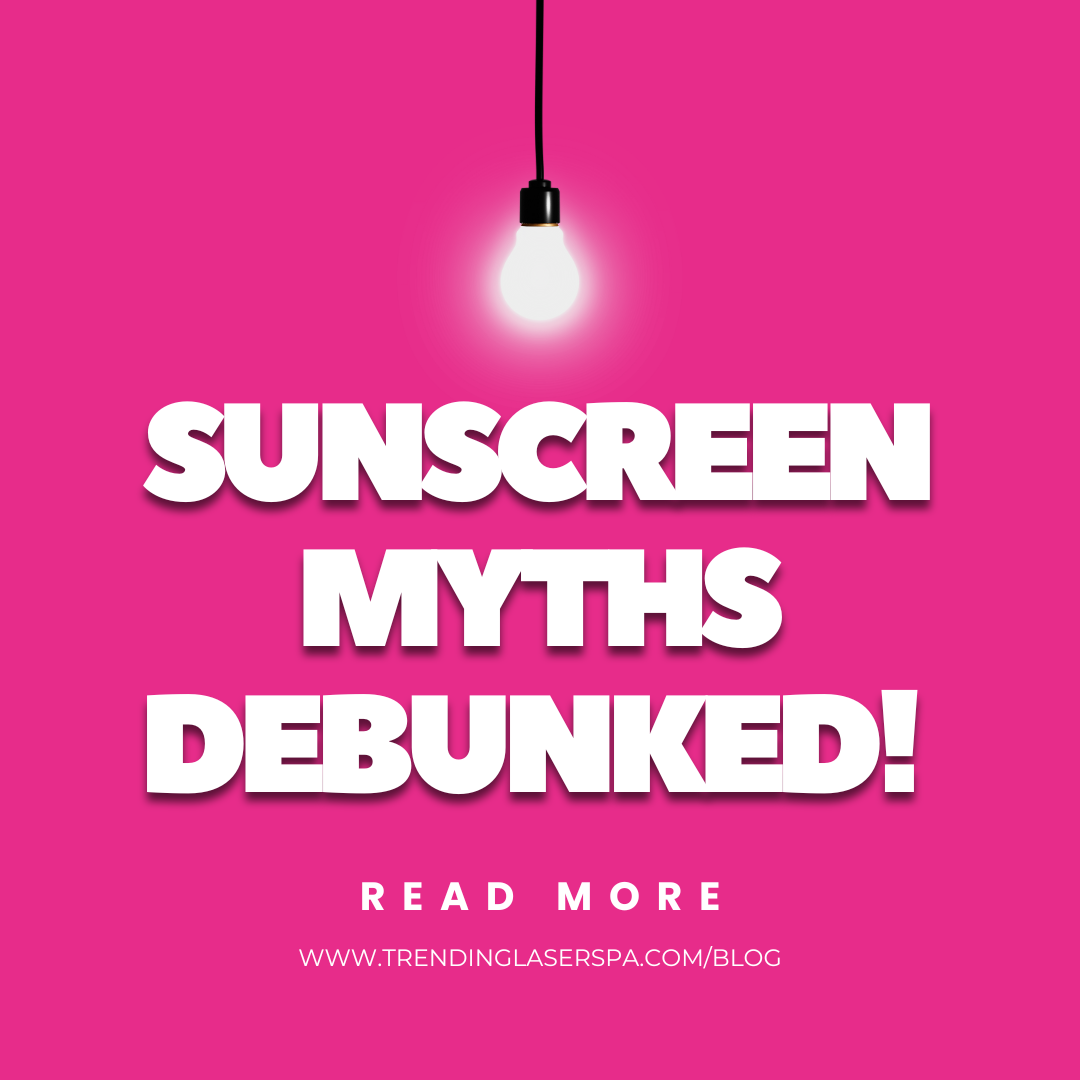
18 Nov Sunscreen Myths Debunked
I’m often asked by my clients during consultations for laser treatments or other skin procedures about which sunscreen to use, how often to apply it when out in the sun, whether sunscreen use varies in winter vs. summer, and if the same sunscreen can be used year-round in Canada or when vacationing abroad. Additionally, there are many myths surrounding sunscreen and its proper use.
In this blog, I’ll address some of the biggest sunscreen myths that have persisted for years and why it’s time they be debunked.
Based on my knowledge and further research, it is generally okay to use the same SPF year-round, but there are some nuances to consider depending on the climate and how your skin reacts to sun exposure.
SPF Basics
Sun Protection Factor (SPF) measures how well a sunscreen protects against UVB rays, which are the primary cause of sunburn and contribute to skin cancer. The higher the SPF, the more protection you get. For example, SPF 30 blocks about 97% of UVB rays, while SPF 50 blocks about 98%.
SPF Year-Round
SPF should be part of your daily skincare routine every day, regardless of the season. UV rays can damage your skin even when it’s cloudy, cold, or snowy, and they can penetrate through windows. This applies to all locations, including Canada, where you might have long winters or a colder climate. In fact, snow can amplify UV exposure because it reflects UV rays, increasing the amount of exposure your skin receives.
However, depending on seasonal factors, you might adjust other aspects of sun protection:
Key Considerations:
1. Winter (Cold, Snowy Weather):
○ In colder months, people often spend more time indoors, which can mean less direct sun exposure. However, if you’re spending time outside, especially in snowy conditions, you should continue using sunscreen.
○ Snow can reflect up to 80% of UV rays, which increases exposure, particularly to areas like your face and hands. In these cases, you might want to use a broad-spectrum sunscreen with a higher SPF (50+), especially if you’re skiing or engaging in outdoor activities.
2. Summer (Hot, Sunny Weather):
○ During the warmer months, UV exposure is higher, and you might need to reapply sunscreen more frequently (every 2 hours or after swimming or sweating).
○ In summer, you might also opt for water-resistant sunscreens for activities like swimming, hiking, or sports.
3. Changes in Latitude:
○ If you’re traveling to sunnier locations (or high altitudes), you may want to consider using a higher SPF. The sun’s intensity is stronger closer to the equator or at higher elevations.
4. Skin Sensitivity & Type:
○ Your skin type or any sensitivities (such as rosacea or post-procedure healing) may warrant a more tailored approach, even if you’re not directly adjusting for the season.
In short:
• SPF doesn’t need to change drastically based on the weather; however, if you’re spending more time outside in winter or summer, you might adjust the type of sunscreen you use (e.g., higher SPF, water-resistant formulas).
• You can stick with the same SPF throughout the year, but make sure you’re reapplying it regularly, especially if you’re outside for extended periods, regardless of season.
Sunscreen Myths Debunked
There are several common myths about sunscreen that can lead to confusion and improper sun protection. Addressing these myths can help your readers and clients understand how to effectively use sunscreen to protect their skin. Here are some of the most well-known myths and facts around those myths:
1. Myth: Sunscreen isn’t needed on cloudy or rainy days.
• Fact: UV rays can penetrate through clouds, meaning your skin is still vulnerable to sun damage even when it’s overcast. In fact, up to 80% of UV rays can reach the Earth on cloudy days. It’s important to wear sunscreen every day, regardless of the weather.
2. Myth: You don’t need sunscreen in the winter.
• Fact: UV rays are still present in winter, especially in snowy conditions. Snow can reflect up to 80% of UV rays, intensifying exposure to your skin. If you’re skiing, hiking, or spending time outdoors, you still need sunscreen to protect against both UVA and UVB rays.
3. Myth: Higher SPF means you don’t need to reapply sunscreen.
• Fact: While higher SPF does provide more protection, it doesn’t last indefinitely. SPF 30 or higher blocks a higher percentage of UVB rays, but no sunscreen is 100% effective. Reapplication every two hours is necessary, especially after swimming, sweating, or towel drying.
4. Myth: Sunscreen can’t be used after it expires.
• Fact: Sunscreen can lose its effectiveness after its expiration date, but it doesn’t become dangerous or harmful to use. It’s always best to check the expiration date and make sure the sunscreen has been stored correctly (in a cool, dry place). Using expired sunscreen may not provide adequate protection.
5. Myth: Sunscreen is only necessary on your face.
• Fact: Sunscreen should be applied to all exposed areas of the skin, including your neck, ears, chest, hands, and even your lips. The skin on your body is equally susceptible to sun damage, premature aging, and skin cancer, so don’t forget those areas!
6. Myth: Sunscreen is only necessary if you’re spending a long time in the sun.
• Fact: Even short-term sun exposure can damage your skin, and over time, this adds up. Daily sunscreen use is essential to protect your skin from cumulative UV damage, which can lead to premature aging, wrinkles, and even skin cancer.
7. Myth: You don’t need sunscreen if you’re wearing makeup with SPF.
• Fact: While some makeup products contain SPF, they often don’t provide enough protection on their own. To get the full benefit of SPF, you need to apply the recommended amount of sunscreen (about a shot glass full for your face and neck) before your makeup. You can then top up with SPF-containing makeup, but it shouldn’t replace your sunscreen.
8. Myth: Sunscreen protects only against sunburn.
• Fact: Sunscreen protects against both UVB (which causes sunburn) and UVA (which contributes to premature aging and skin cancer). Look for broad-spectrum sunscreen that offers protection against both types of UV rays.
9. Myth: Natural or organic sunscreens are always safer or more effective.
• Fact: While natural sunscreens (like those with zinc oxide or titanium dioxide) are effective and often gentle, not all “natural” sunscreens are created equal. Many commercial sunscreens, whether mineral or chemical, are tested to provide high levels of protection. The key is to choose broad-spectrum sunscreen that suits your skin type and lifestyle.
10. Myth: Sunscreen is only for the summer.
• Fact: Sunscreen should be worn every day of the year, not just during the summer months. UV rays can cause damage all year round, even on colder days, and are stronger in areas with higher altitudes or closer to the equator. Whether it’s snowing, raining, or sunny, your skin needs protection.
11. Myth: Sunscreen causes vitamin D deficiency.
• Fact: Sunscreen does reduce UVB exposure, but it does not block it completely. The amount of UVB rays needed for vitamin D production can still penetrate the skin, especially if you’re exposed to the sun for short periods. If you’re concerned about vitamin D levels, you can talk to a healthcare provider about supplements or sun exposure in moderation, but the risk of skin damage and cancer is far greater than the risk of vitamin D deficiency.
12. Myth: You can’t get sunburned while driving or sitting near windows.
• Fact: UV rays can penetrate glass, meaning that even sitting in a car or near windows exposes your skin to potential damage. In fact, people who drive frequently can develop more sun damage on the side of their face that faces the window. Use sunscreen on exposed areas of your body, even while inside.
13. Myth: Sunscreen is only necessary for fair-skinned people.
• Fact: Everyone needs sunscreen, regardless of skin color. While darker skin tones have more melanin, which provides some natural protection against UV rays, they are still susceptible to sun damage, premature aging, and skin cancer. Everyone, regardless of skin type, should use broad-spectrum sunscreen to protect their skin.
14. Myth: Spray sunscreens are just as effective as cream sunscreens.
• Fact: Spray sunscreens can be convenient, but they often don’t provide even coverage and can be difficult to apply adequately. It’s also easy to miss spots or apply too little. Cream or lotion sunscreens tend to be more effective, as they ensure a more thorough application. If you prefer spray sunscreen, make sure you apply it generously and rub it in for even coverage.
I hope this blog helps my readers, clients, and potential clients understand the importance of using sunscreen year-round, whether in Canada or elsewhere. Sunscreen is essential not just in the summer, but throughout the year—protecting your skin from UV damage, even in winter or on cloudy days. We’ve also debunked some common myths, like the idea that sunscreen isn’t necessary in colder weather or that it doesn’t need reapplication. By making sunscreen a daily habit and using it properly, you’re taking a simple yet powerful step toward healthier, more youthful skin for years to come.

No Comments